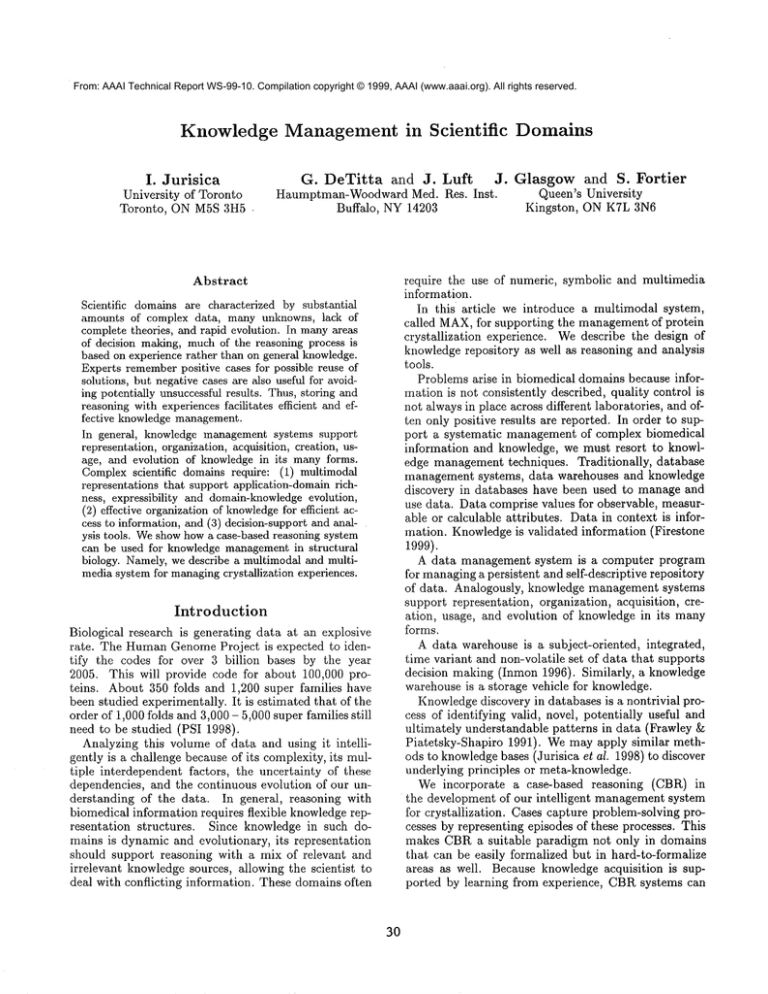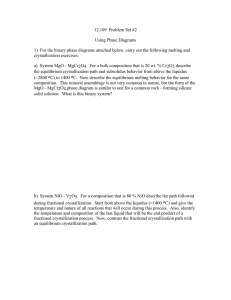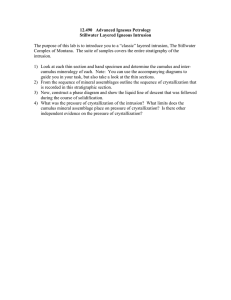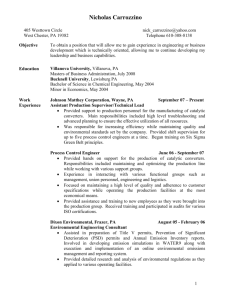
From: AAAI Technical Report WS-99-10. Compilation copyright © 1999, AAAI (www.aaai.org). All rights reserved.
Knowledge Management in Scientific
I. Jurisica
University of Toronto
Toronto, ON M5S 3H5
G. DeTitta
and J. Luft J.
Haumptman-Woodward Med. Res. Inst.
Buffalo, NY14203
Domains
Glasgow
and S. Fortier
Queen’s University
Kingston, ON K7L 3N6
require the use of numeric, symbolic and multimedia
information.
In this article we introduce a multimodal system,
called MAX,for supporting the managementof protein
crystallization
experience. Wedescribe the design of
knowledgerepository as well as reasoning and analysis
tools.
Problems arise in biomedical domains because information is not consistently described, quality control is
not always in place across different laboratories, and often only positive results are reported. In order to support a systematic management of complex biomedical
information and knowledge, we must resort to knowledge management techniques. Traditionally,
database
management systems, data warehouses and knowledge
discovery in databases have been used to manage and
use data. Data comprise values for observable, measurable or calculable attributes. Data in context is information. Knowledgeis validated information (Firestone
1999).
A data management system is a computer program
for managinga persistent and self-descriptive repository
of data. Analogously, knowledge management systems
support representation, organization, acquisition, creation, usage, and evolution of knowledge in its many
forms,
A data warehouse is a subject-oriented, integrated,
time variant and non-volatile set of data that supports
decision making (Inmon 1996). Similarly, a knowledge
warehouseis a storage vehicle for knowledge.
Knowledgediscovery in databases is a nontrivial process of identifying valid, novel, potentially useful and
ultimately understandable patterns in data (Frawley
Piatetsky-Shapiro 1991). Wemay apply similar methods to knowledgebases (Jurisica et al. 1998) to discover
underlying principles or meta-knowledge.
We incorporate a case-based reasoning (CBR)
the development of our intelligent
managementsystem
for crystallization. Cases capture problem-solving processes by representing episodes of these processes. This
makes CBRa suitable paradigm not only in domains
that can be easily formalized but in hard-to-formalize
areas as well. Because knowledge acquisition is supported by learning from experience, CBRsystems can
Abstract
Scientific domainsare characterized by substantial
amounts of complex data, many unknowns, lack of
complete theories, and rapid evolution. In manyareas
of decision making, muchof the reasoning process is
based on experience rather than on general knowledge.
Experts rememberpositive cases for possible reuse of
solutions, but negative cases are also useful for avoiding potentially unsuccessful results. Thus, storing and
reasoningwith experiences facilitates efficient and effective knowledgemanagement.
In general, knowledge managementsystems support
representation, organization, acquisition, creation, usage, and evolution of k_nowledgein its manyforms.
Complexscientific domains require: (1) multimodal
representations that support application-domainrichness, expressibility and domain-knowledge
evolution,
(2) effective organizationof l~owledgefor efficient access to information, and (3) decision-support and analysis tools. Weshowhowa case-based reasoning system
can be used for knowledgemanagementin structural
biology. Namely,we describe a multimodaland multimediasystem for managingcrystallization experiences.
Introduction
Biological research is generating data at an explosive
rate. The HumanGenomeProject is expected to identify the codes for over 3 billion bases by the year
2005. This will provide code for about 100,000 proteins. About 350 folds and 1,200 super families have
been studied experimentally. It is estimated that of the
order of 1,000 folds and 3,000 - 5,000 super families still
need to be studied (PSI 1998).
Analyzing this volume of data and using it intelligently is a challenge because of its complexity, its multiple interdependent factors, the uncertainty of these
dependencies, and the continuous evolution of our understanding of the data. In general, reasoning with
biomedical information requires flexible knowledgerepresentation structures. Since knowledge in such domains is dynamic and evolutionary, its representation
should support reasoning with a mix of relevant and
irrelevant knowledgesources, allowing the scientist to
deal with conflicting information. These domains often
3O
supplement weak domain models. This requires representation formalisms which preserve relations among
cases and also among their parts. CBRcan represent
existing experiences, deal with exceptions and contradictory information, evolve representation over time,
change the use of information at a later time, and be
effectively integrated with other systems.
Knowledge
integration with other techniques. This is in fact a combination of two research schools - one that builds models of humanperformance in science and the other that
builds effective programs, which may be implausible in
human terms (Valdez-Perez 1995).
TA3is a CBRsystem which uses a variable-context
similarity-based retrieval algorithm and a flexible representation language (Jurisica & Glasgow 1997; Jurisica
etal. 1998; Jurisica, Glasgow, g~ Mylopoulos 1999).
Cases are represented as a collection of attribute-value
pairs. Individual attributes are grouped into one or
more categories. Categories bring additional structure
to a case representation. This reduces the impact of
irrelevant attributes on system performance by selectively using individual categories during matching. As
a result, we get a more flexible reasoning system, a
more comprehensible presentation of complex information, improvedsolution quality, and increased scalability.
We extend basic CBRfunctionality
in TA3 by providing: (1) image-based processing to extend expressibility (Glasgow & Jurisica 1998), (2) database techniques for case retrieval to support scalability (Jurisica,
Glasgow, & Mylopoulos 1999), (3) knowledge-discovery
techniques to support domain-knowledge evolution and
system optimization (Jurisica etal. 1998). The knowledge discovery componentis used for three purposes:
Management
The application
of knowledge-based technology to
biomedical domains presents many challenges. These
challenges arise from the complexity of biomedical
knowledge characterized by a large number of interdependent factors, from the uncertainty of dependencies, and from its constant evolution. It is imperative that biomedical decision-support systems specifically address these challenges.
Decision-support systems have previously been applied to several problem in the domain of structural
biology, for example: to help to identify protein secondary structures (Lent, Buchanan, & Nicholas 1993);
to assist in locating motifs (Glasgow, Steeg, &Fortier
1999), to find similarity betweenprotein tertiary structures (Grindley etal. 1994); and to help during the
initial stage of drug discovery (Finn et al. 1998).
Someof the main problems to be solved in the development of intelligent support systems are howto represent information, howto access it flexibly and efficiently
(Finn etal. 1998), how to analyze it (Conklin, Fortier,
~; Glasgow 1993), and how to reason with it during
decision making. Given the uncertainties present, the
diversity of the representation formalism used, the complexity and amountof information present, and the evolution of domain knowledge, it is necessary that the
information system that will assist decision-making in
structural biology be flexible and scalable. The retrieval
of biomedical knowledgeis difficult because of its various forms, diversity of its locations, and its potential to
be contradictory.
Biological domains require multimodal representation that supports expressibility and domain-knowledge
evolution. Althoughdiverse tools need to be used, casebased reasoning can be the core technology due to its
potential flexibility in managing experience. Next we
discuss how a case-based reasoning system can be used
for the managementof crystallization experiments.
¯ TA3 optimization: locating descriptors relevant for
a given context and task, and organizing a case base
into context-based clusters.
¯ Case base and domain knowledge evolution: adding
descriptors to assist case discrimination during prediction and classification; removing redundant cases
and descriptors; creating hierarchies of descriptors
and their values; finding associations.
¯ Evidence-based reasoning: analyzing created clusters, hierarchies and associations to identify underlying principles in the domain.
Management of Crystallization
Experiences
Structural biology is an important componentof biological research. A standard method for protein structure
determination is single crystal X-ray diffraction. This
process is often limited by the difficulty of growingsingle crystals suitable for diffraction. Reasonsfor this include the large numberof parameters affecting the crystallization outcome(e.g., purity of macromolecules,intrinsic physico-chemical parameters, biochemical, biophysical and biological parameters), the unknowncorrelations between the variation of a parameter and the
propensity for a given macromoleculeto crystallize.
Although some advances have been made, the crystallization of macromoleculesis still primarily empirical. Because of its unpredictability and high irreproducibility, it has been considered by someto be an art
rather than a science (Ducruix & Giege 1992). Practical experience produces theories that are effective in
7-¢43 Case-Based
Reasoning System
Wepropose to consider the representation of biomedical
knowledge using a combination of case-based, imagebased, and rule-based approaches. Selecting a particular formalism may require a tradeoff between information expressibility that the formalism supports, and
scalability of the system that uses the formalism. In
addition, an effective knowledgerepresentation formalism supports knowledgeevolution (Jurisica et al. 1998).
Our approach takes CBRas the core system for knowledge managementand extends its functionality through
31
many settings.
For example, Jancarik and Kim proposed a set of 48 crystallizing agents that are often successfully used during crystallization (Jancarik ~: Kim
1991). These agents were proposed based on empirical results. Thus, "further work in the systematic study
of the chemical and physical properties associated with
crystallization should provide additional improvements
in the ability to grow protein crystals" (PSI 1998).
An additional
problem is an historically
nonsystematic approach to knowledge acquisition - "the
history of experiments is not well known, because crystal growers do not monitor parameters." (Ducruix g~
Giege 1992). For example, the Biological Macromolecular Crystallization Database (BMCD)stores data from
published crystallization
papers, including information about the macromoleculeitself, the crystallization
methods used, and the crystal data (Gilliland 1988).
Unfortunately, negative results are not reported, and
many crystallization
experiments are not reproducible
because of incomplete method descriptions, missing details, or erroneous data. Our recent literature review
indicates that the BMCD
is not being used in a strongly
predictive fashion.
Our main goal is to support the management of
protein crystallization experiences by creating a useflll
crystallization
knowledge warehouse. Conceptually, we
can divide the crystal-growth process into a primary
phase, during which one searches for favorable initial
crystallization conditions, and a secondary phase, during which the initial conditions are optimized. Usually,
the primary phase is the more time consuming of the
two. Our research focuses on identifying initial conditions favorable for crystal growth as quickly as possible. The proposed approach has the potential to significantly reduce the time spent looking for initial conditions. The results of our research may thus eliminate
the primary bottleneck in modern structural biology.
Wepostulate that past experience can lead us to the
identification of initial conditions favorable to crystallization. Faced with the challenge of crystallizing a new
protein we suggest that successful recipes developed for
similar proteins may be optimal starting points for the
lab work. However, we are faced with a problem of
quantitatively measuring the similarity of two proteins.
Wehypothesize that solubility experiments can provide a quantitative measure of similarity between two
proteins. Assume that two proteins react similarly
when tested against a reasonably large set of precipitating agents. Wesuggest that crystallization strategies successfully employedfor the one maybe profitably
applied to the other. Thus, we need to identify a suitable set of precipitating agents to sort the outcomes of
reactions for a relatively large group of proteins, all of
which have been successfully crystallized before. New
crystallization
challenges are then approached by the
execution and analysis of a small set of precipitation reactions, followed by the identification of similar proteins
and further analysis of the recipes successfully used to
crystallize them. The precipitation reactions are de-
signed to consume less than a milligram of protein, to
take a few hours to set up, and to take around 12 hours
to analyze.
Our goals are to create a knowledgerepository, develop software tools to analyze the outcomes and suggest starting conditions for crystal growth experiments,
to develop a protocol for the execution of a set of precipitation reactions, and to design protocols for the visual
interpretation of the reaction outcomes. To be specific,
we have designed the decision-support system to identify the following pieces of information for the crystal
grower: (1) the crystallization methodof choice; (2)
crystallizing agent of choice; (3) the optimal temperature; (4) the optimal pH; and (5) the approximate
centrations of all solutes required in the crystal growth
medium.
Crystallization experiments contain experiential information, such as initial input information about the
protein at the beginning of the experiment, the process of carrying out the experiment and the outcome
of the experiment. Knowledgeevolves regardless of our
wishes due to environment changes, the emergence of
new problems or modification of our goals, user model
changes, and the evolution of our understanding of
the surrounding world resulting from the discovery of
new relationships and principles. A case representation
must be flexible to handle these issues. CBRsuggests
a model for computational reasoning that incorporates
problem solving, understanding and learning. Wepropose to incorporate CBRto perform two functions: (1)
to suggest almost-right solutions to problems, which
can be modified automatically (or by the expert user)
to suit the new protein situation, and (2) to warn
potential errors or failures in a proposed experimental
plan.
Max, the proposed system for crystallization experiment design is multimodal and multimedia. It incorporates diverse tools (knowledge discovery, image feature
extraction, similarity-based retrieval), reasoning algorithms (case-based, image-based and rule-based reasoning), and an information repository (multiple databases
and a knowledge base). On the conceptual level, the
information repository contains data and knowledge.
Data comprises existing databases, such as PDB(Protein Data Bank), BMCD,and specialized information
about proteins, chemicals, and agents. Knowledge in
MAX’srepository has two forms - experiential (cases
in the case base) and general principles (e.g., adaptation rules). MAX’sknowledgerepository is created systematically with an emphasis on information quality
(i.e., correctness, completeness, reproducibility). The
case base stores cases, which are individual experiments with diverse crystallization outcomes(e.g., nothing happened, amorphous precipitate, crystalline precipitate, prisms). General principles can be useful rules
acquired from crystallographers, or principles derived
using knowledge-mining tools. These are needed during the case adaptation process.
The need for image-based reasoning comes from the
32
fact that there is no general solution to quantitatively
evaluate reaction outcomes under the microscope. The
major weakness of existing scoring methods is the tendency to confuse micro crystalline and amorphous precipitates (Ducruix & Giege 1992). For this reason
store crystallization
outcomes as images. Weuse computer vision techniques (Glasgow &~ Jurisica 1998)
preprocess images (i.e., image alignment, recognizing
precipitates in the micro pipette, etc.), to automatically recognize different crystallization outcomes, and
to extract important image features for further analysis. It is important to note that this approach produces
objective results, and thus may have the potential to
be useful during knowledgediscovery.
Current
Implementation
Status
of MAX
To support scalability,
we have redesigned and reimplemented 7-,43. The core of the library has been
implemented in Java. Wehave extended the case management module to enable easier migration of cases, to
support multimedia storage, and to improve scalability. Currently, T.A3 works with both a memory-resident
case repository and a JDBC-compliant database (e.g.,
IBM DB2 UDB).
Weplan to evaluate individual components of MAX
as we progress, but the final evaluation will be done after the information repository is populated and all reasoning and analysis tools implemented. The ultimate
test is to take unknownproteins, use MAX
to suggest
crystallization strategies, and evaluate the results.
Using a limited data set, we have tested the suitability and accuracy of similarity-based retrieval using
the solubility reaction index. A similarity function was
used to determine which cases are most relevant to the
given problem. Currently we incorporate precipitation
indices as a quantitative measure of similarity.
The
index encodes precipitation reactions from a set of initial precipitation cocktails as a binary string. As the
project develops we will also consider other attributes
(such as protein sequence, molecular weight, etc.) and
assess their usefulness in the retrieval stage of the system. The context-based retrieval method, implemented
in the TA3 system, provides the user with a flexible
interface for restricting or relaxing the context in order to retrieve fewer or more cases as necessary. The
relaxation preferences for the reaction index category
were initialized to favor reduction over generalization.
Our preliminary results indicate that TA3’s variable
context, similarity-based retrieval moduleis suitable in
protein crystallography domain. However, our evaluation is limited by the fact that reaction index was based
on only 160 precipitation reactions performed. Currently, we are acquiring experimental data with a significantly larger numberof precipitation reactions and
for many more proteins.
The image processing system is divided into the retrieval and analysis modules. The retrieval moduleuses
a simplified version of TA3’svariable context retrieval.
Each case is assumed to have only one attribute, which
is a two-dimensional array of values. Contexts are represented by two arrays indicating a maximumand a
minimum. Thus, the domain of a context is a continuous range of values. Contexts can be specialized and
generalized, and sets of cases support regular and iterative retrieval, as well as an explain function. A set of
cases is represented as a list of images resulting from a
set of experiments.
The analysis moduleis used to extract features from
the raw image to create a case. Image preprocessing
isolates the region of interest in the image (i.e., the
contents of the micro pipette) and attempts to standardize images with regards to lighting, size and orientation. Post-processing implements the classification
strategy. While we investigate several possible strategies, currently only the analysis of the two-dimensional
Fourier transform is implemented.
Althoughthis is still only a prototypical version, our
preliminary results are encouraging. Wecan now automatically clean up and align images, evaluate their similarity, and classify them into categories of "nothing happened" and "something happened" (e.g., amorphous
precipitate, crystalline precipitate). Weare working on
extending the current implementation with additional
algorithms for image feature extraction.
Discussion
Successful knowledge management must be systematic.
Without it, important data might be missing or incorrect, the representation formalism may be limited,
or only a subset of available experience maybe represented. Recently, other groups approached the problem of crystallography experiment design (Rosenberg
et al. 1999). Similarly to our approach, they start by
systematically archiving information about crystallization experiments, using machine-learning techniques to
identify regularities in data, and suggest plausible crystallization experiments.
%’aditionally,
CBP~focuses on technical domains
or clinical
medicine. Knowledge warehousing has
been introduced in business-oriented domains (Firestone 1999). Our approach extends both CBRand
knowledge warehousing techniques and applies them to
scientific domains.
CBB. is an important paradigm for knowledge management because: (a) it is similar to human problem
solving and thus it can complement the user; (b)
supports evolving domain models and thus can help to
increase domain understanding; and (c) it diminishes
the problem of exceptions and over-generalizations.
Flexible similarity-based retrieval is required in complex application domains (Jurisica et al. 1998). It
is also critical in biomedical domains, because similar
structures are likely to have similar biological activities. It is, however, paramount that the case retrieval
in such domainsbe scalable and user-guided, leading to
conversational
CBR(Munoz-Avila ~ Aha 1999). The
prototype system 7-,43 can be used to satisfy these features (Jurisica ~ Glasgow 1997; Jurisica et al. 1998;
Jurisica, Glasgow, & Mylopoulos 1999). Further work
is needed to extend the model to support reasoning
about images, including automated extraction of image
features and the assessment of geometric and spatial
similarities
(Glasgow ~ Jurisiea ]998). Our preliminary results show that taking this multimodal approach
to representation and reasoning has substantial benefits
for knowledge management(Luft et al. 1999). Once the
prototype becomespublicly accessible, additional problems with quality assurance will need to be addressed.
The unique aspect of this research is in its focus on
domains where processing only symbolic information is
not sufficient and where one representation formalism
is not adequate to satisfy diverse users and support various tasks. The combination of a CBRparadigm with
computer vision techniques may bring advances to decision support in this and similar domains. In addition, due to problem complexity, we focus on interactive rather than automatic tools. Results of this research are applicable beyond biomedical domains, provided experience-based reasoning is applicable. 1
If biomedical decision-support systems (DSSs) can
address these challenges, two important goals will simultaneously be achieved: (1) research in computing
will be more focused and wouldprogress faster since real
world data is being used; and (2) research in biomedical domains will be enhanced by the application of
new technology, which may help to establish underlying
principles.
AAAI’98 Workshop on Case-Based Reasoning, 67-74.
Madison, WI: AAAIPress.
Glasgow, J.; Steeg, E.; and Fortier, S. 1999. Motif discovery in protein structure database. In Wang;
Shapiro; and Shasha., eds., Pattern Discovery in
molecular Biology: Tools, Techniques and Applications. Oxford University Press. To appear.
Grindley, H. M.; Artymiuk, P. J.; Rice, D. W.; and
Willett, P. 1994. Identification of tertiary structure
resemblance in proteins using a maximal commonsubgraph isomorphism algorithm. Journal of Molecular
Biology 229(3):707-721.
Inmon, W. H. 1996. nd
Building the data warehouse, 2
Edition. NewYork, NY: J. Wiley.
Jancarik, J., and Kim, S. H. 1991. Spare matrix sampling: a screening method for crystallization of proteins. J. Appl. Cryst. 24(409).
Jurisica, I., and Glasgow, J. 1997. Improving performanceof case-based classification using context-based
relevance. International Journal of Artificial Intelligence Tools, Special Issue of ICTAI’96 Best Papers
6(4):511-536.
Jurisica, I.; Mylopoulos,J.; Glasgow,J.; Shapiro, H.;
and Casper, R. F. 1998. Case-based reasoning in IVF:
Prediction and knowledge mining. Artificial Intelligence in Medicine, Special Issue on CBRin Medicine
12(1):1-24.
Jurisica, I.; Glasgow, J.; and Mylopoulos, J. 1999.
Building efficient conversational CBRsystems. Incremental iterative retrieval and browsing. Submitted.
Leng, B.; Buchanan, B. G.; and Nicholas, H. B. 1993.
Protein secondary structure prediction using two-level
case-based reasoning. In ISMB’93.
Luft, J. R.; Bianca, M.; Jurisica, I.; Rogers, P.; Glasgow, J.; Fortier, S.; and DeTitta, G.T. 1999. An
opening strategy for macromolecular crystallization:
Case-based reasoning and the exploitation of a precipitation reaction outcome database. In Conference of
the American Crystallography Association.
Munoz-Avila, H., and Aha, D. W. 1999. Special issue
on interactive case-based reasoning. Applied Intelligence: The International Journal of Artificial Intelligence, Neural Networks and Complex Problem-Solving
Technologies.
PSI. 1998. National Institute of General Medical Sciences; Protein Structure Initiative meeting summary.
References
Conklin, D.; Fortier, S.; and Glasgow, J. 1993. Knowledge discovery in molecular databases. IEEE Transactions on Knowledge and Data Engineering 5(6):985987.
Ducruix, A., and Giege, R. 1992. Crystallization
of Nucleid Acids and Proteins. A Practical Approach.
NewYork: Oxford University Press.
Finn, P.; Muggleton, S.; Page, D.; and Srinivasan, A.
1998. Pharmacophore discovery using the inductive
logic programming system progol. Machine Learning
30(2-3) :241-270.
Firestone, J. M. 1999. Knowledge base management
systems and the knowledge warehouse: A "strawman".
http://km,org/AKMS/AKMSst
rawbak.hC,
ml.
Frawley, J., and Piatetsky-Shapiro, G. 1991. Knowledge Discovery in Databases. AAAIPress.
Gilliland, G. 1988. Biological macromolecule crystallization database. Journal of Crystal Growth 90(51).
Glasgow,J., and Jurisica, I. 1998. Integration of casebased and image-based reasoning. In Aha, D. W., ed.,
http:
1This work is supported in part by grants from NASA
and NSERC.The authors thank Melissa Bianca of the
Hauptman-Woodward
Medical Research Institute for invaluable help in the wet lab and Patrick Rogersof University
of Toronto for invaluable contributions to the implementation of MAX.
34
/ /www.nih.gov
/nigms/news/reports/protein.~tructure.html,
Rosenberg, J. M.; Wilkosz, P. A.; Martowicz, M.;
Chandeasekhar, K.; Subramanian, D.; Hennessy, D.;
and Buchanan, B. 1999. Intelligent computation aids
for crystal growth. In Conference of the American
Crystallography Association.
Valdez-Perez, R. E. 1995. Computer science research
on scientific discovery. Technical report, Carnegie Mellon University.







